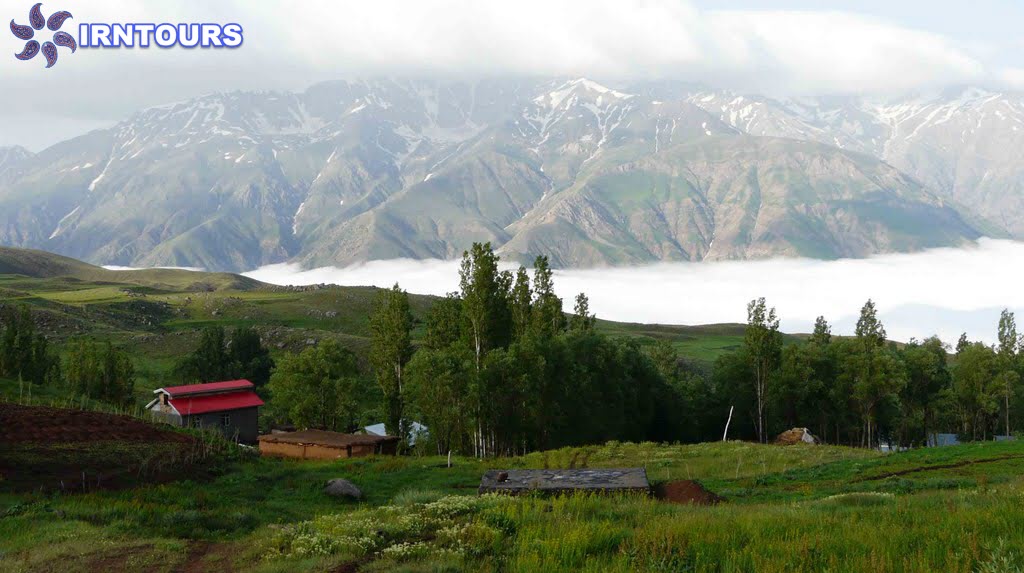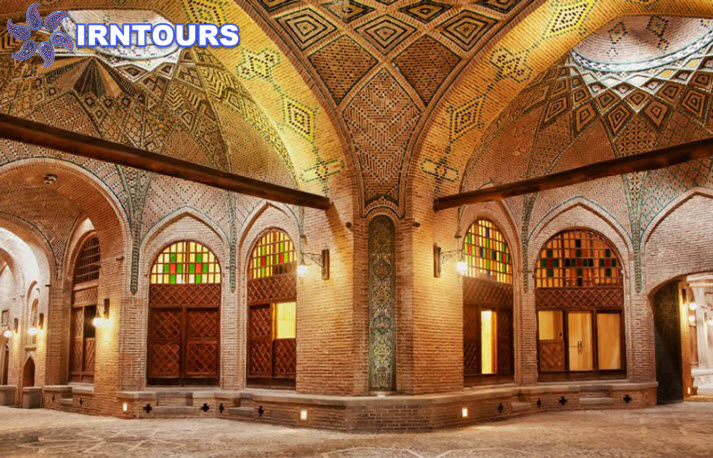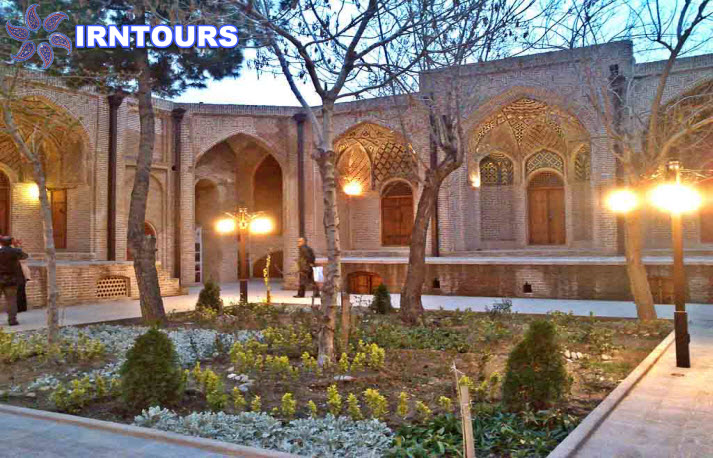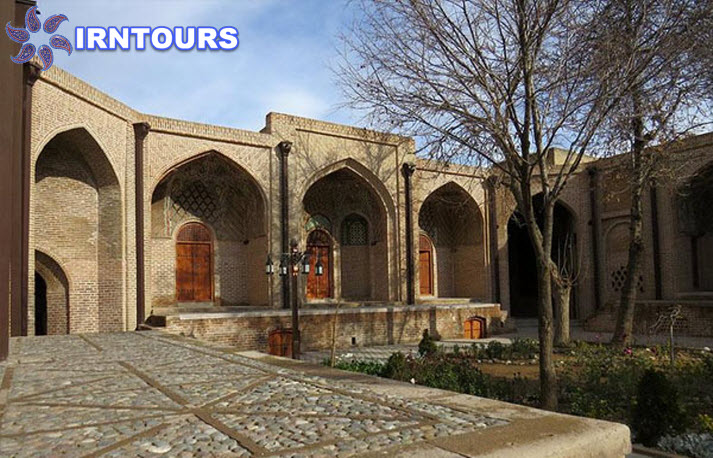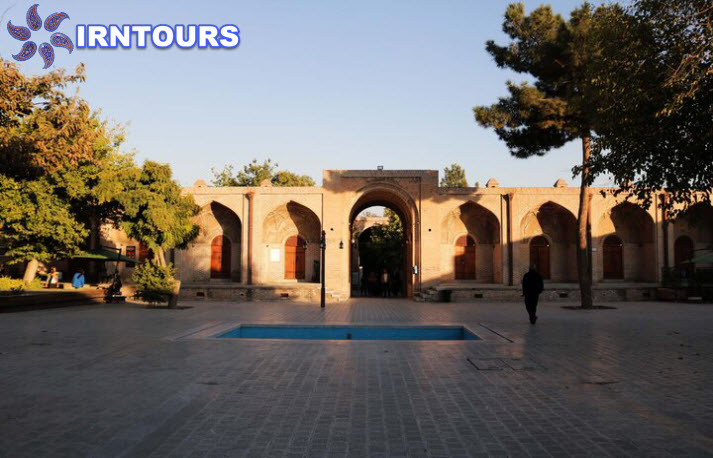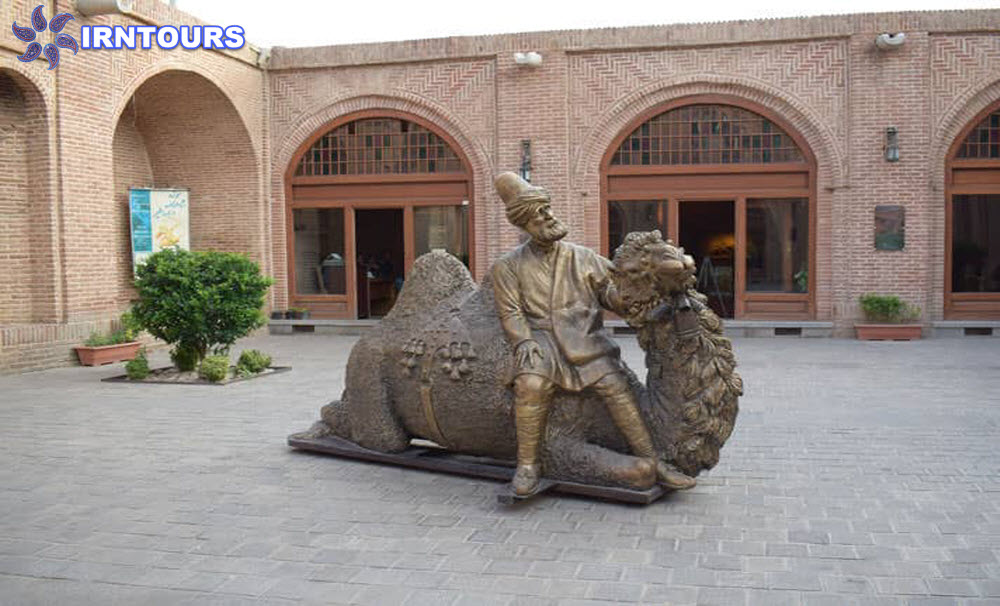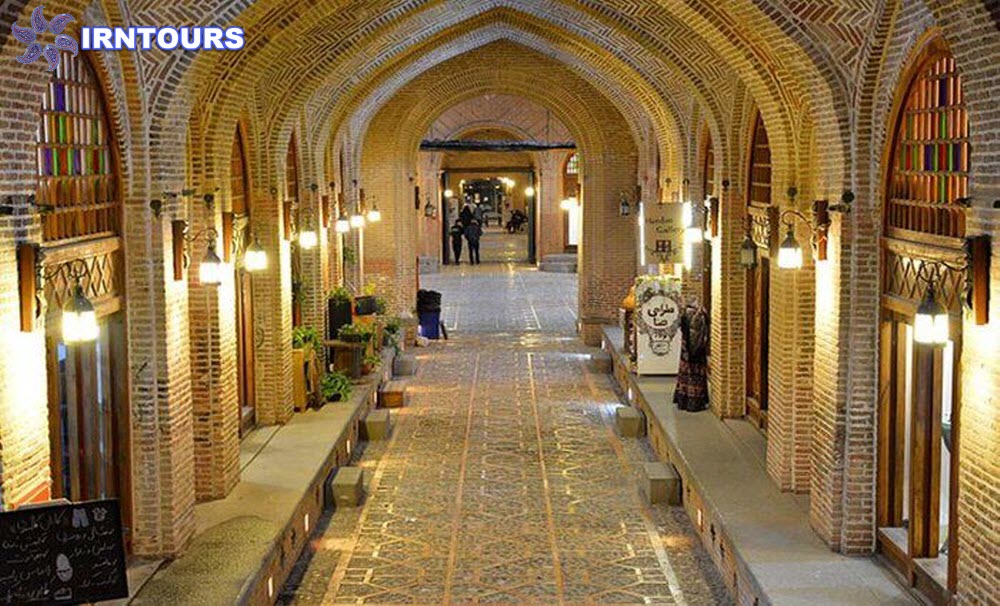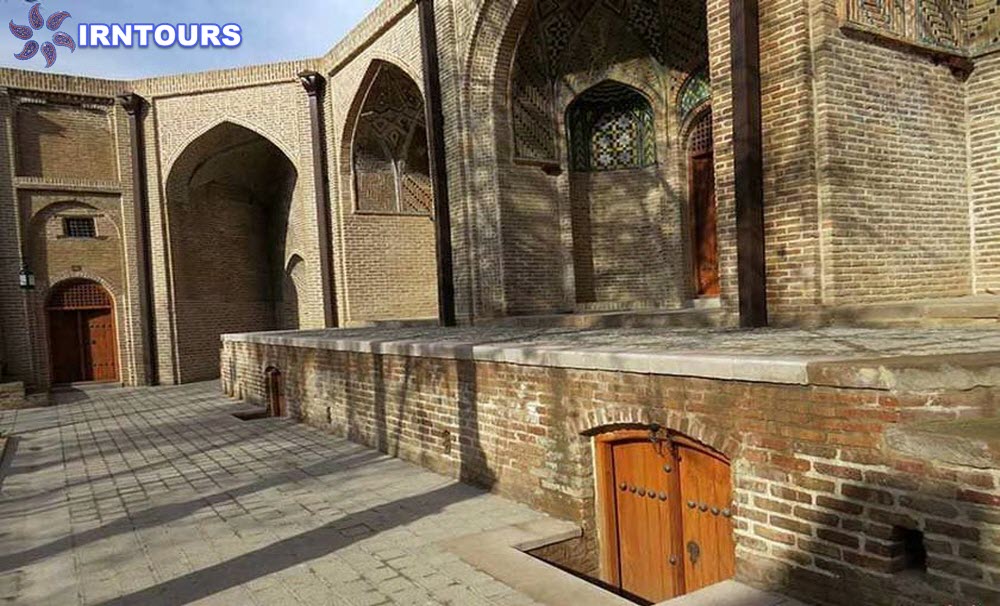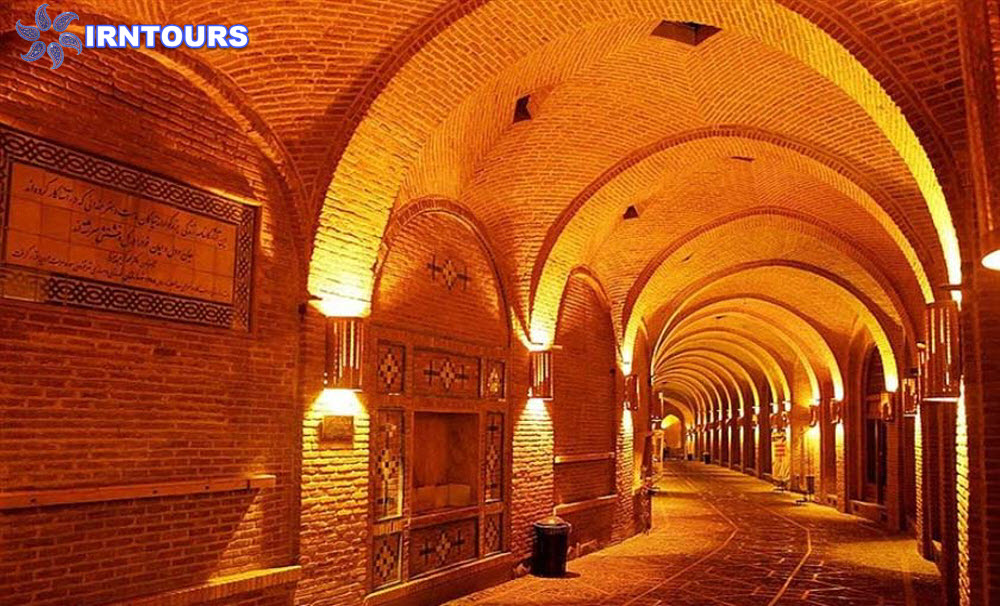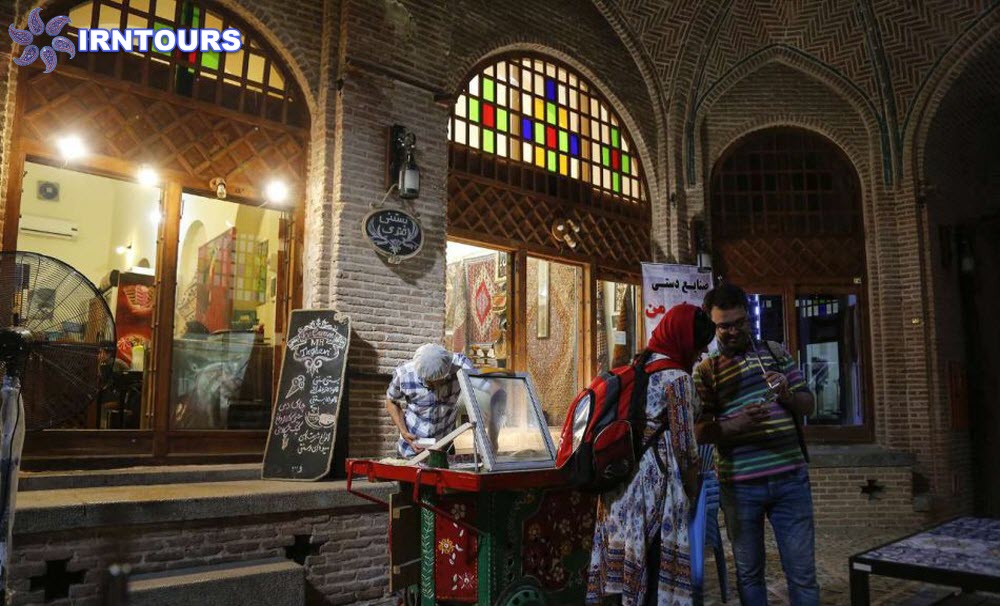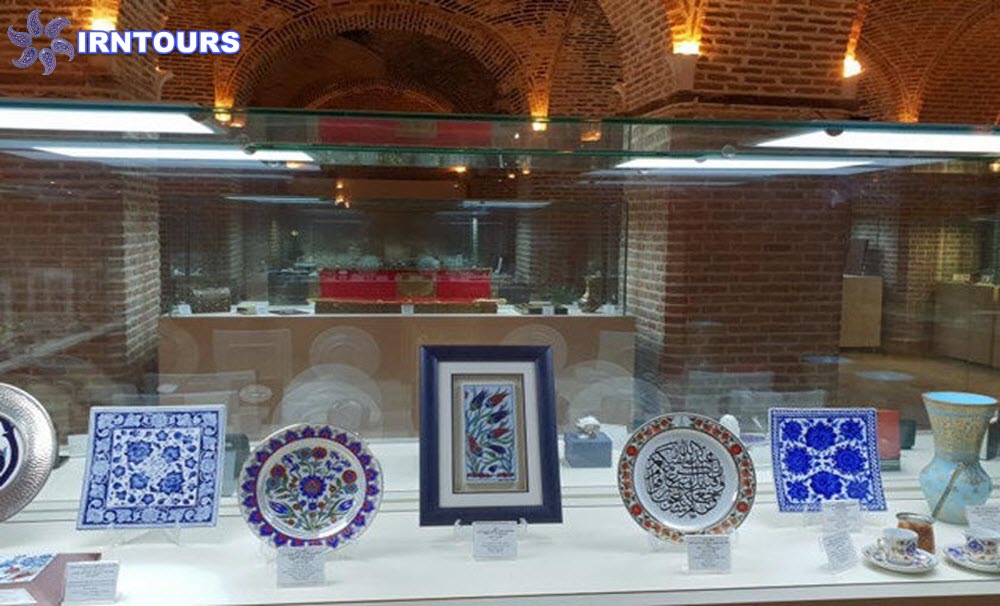About Sa’d al-Saltaneh Caravanserai
The Sa’d al-Saltaneh Caravanserai (سعد السلطنه) is a large Caravanserai located in the city of Qazvin in Qazvin Province of Iran.[1]
Built during the Qajar era, the caravanserai is one of Iran’s best preserved urban caravanserais. The builder (patron) of this large caravanserai was a person by the name Sa’d al-Saltaneh Isfahani (آقا باقر سعد السلطنه اصفهاني), after whom the caravanserai is named.
The caravanserai is built on a square plan, has 4 iwans facing a courtyard. The interiors are decorated with Muqarnas and Rasmi bandi.
The Hujrehs, or the rooms for the travelers, are situated one meter above the courtyard ground level. The Hashti behind the southern iwan has the largest gonbad, with 4 semi-domes adjacent to it.[2]
The eastern-western axis of the Hashti is called Dalan-i Qeisariyeh (دالان قيصريه ) or “Caesar’s Hall”, and the north-south axis of the Caravanserai’s Hashti is named Dalan-i Ghahremani (دالان قهرماني) or “Ghahremani Hall”. The former is connected to the “Bazaar of Vizir” of the city.
There are also two smaller courtyards in the east and west of the Caravanserai.
About Saad al-Saltaneh yard
The size of this yard reaches 3,073 square meters, of which 1,593 square meters is open space and the rest is closed and semi-open space. There are 32 one-story cells on four sides of this courtyard, all of which are built on platforms with a height of one meter from the floor of the courtyard. Under the platforms, small windows are installed so that the air circulates between the platforms and prevent humidity in the cells. The cells have two sections, Ivanche and Pesto. Pesto is a small space behind the cell for extra items, similar to a warehouse. Ivanche stands out with tiling decorations and a formalized roof. Caravans used to come to this yard and use the drinking water of the pond. The floors of the porches and corridors in front of the cells are paved and two corners are created at the intersection of the four sides of the cells.
About Negar al-Saltaneh yard
This courtyard also has two rooms and two very large warehouses, and it opens from the west to the direction of the minister. The yard of Negar al-Sultaneh was where the caravans left their loads and left the place. No one had the right to stay in this place and people had to spend the night in another place. This yard is located in the west of Saad al-Sultaneh yard and its area reaches 1,492 square meters, of which 244 square meters are yard space and the rest are closed and semi-open spaces.
About Ghahremani Yard
On the east side of Shotorkhan, the Ghahremani yard with an area of 1,860 square meters can be seen, of which 706 square meters are dedicated to open space. The Ghahremani yard has a design similar to Beheshtian’s yard and the cells are located on the ground floor. The Ghahremani yard is the only space in the caravanserai that does not have a direct way out of the complex. The courtyard is surrounded by cells and a warehouse is built in its southeast corner.
Service yard
This yard has no cells.
Saadiyeh yard
There is another yard named Saadiyeh in this place, which leads to Saad al-Saltaneh yard from the east. Some consider the most beautiful yard in the complex to be Saadiyeh yard; Because it has more decorations than other yards. This 2,900 square meter courtyard consists of two porches in the north and south, which are decorated with brickwork and tiles. On the northeast side of the courtyard, a corridor with a domed roof can be seen, which has a large dome in the middle and two smaller (circular) roofs. This section has beautiful sashes and its roof includes brick and tile decorations in the form of geometric shapes. The entrance to the Saadiyeh yard is wooden and has a metal cover and decorative studs. There are 10 two-story rooms in this courtyard, which is considered to be the main difference from other courtyards. There is a large colonnade behind the eastern chambers. Sadia bath is also located inside this yard.
Shotorkhan Yard
On the south side of Sarai Qaisarieh, you reach the Shotorkhan yard with an area of 4,378 square meters, which was the entry point for caravans, and if the weather was sunny, they would put their cargo inside the yard. On the north side of this yard, there is a large space with more than 100 columns known as the main dock, where caravans used to unload their loads in bad weather. This space was also used as a stable, and rings for tying horses’ reins were installed on the columns. On the other side, there is a small yard that provided light and air conditioning for the port. The caravans would get tired in this yard and sometimes they would spend the night in the morning. It is located in a large area in the west of the yard, which opens to the direction of the Minister and facing the northern wall of Al-Nabi Mosque.
Beheshtiyan Yard
Beheshtiyan is the name of a restaurant in the northwest of the complex, which can be entered from the north side of Sera and the main street, as well as from the east side of Sera and Saad al-Sultaneh bazaar. Sarai Beheshtiyan consists of two large halls, two porticoes and eight cells. Around Beheshtiyan’s yard, there are rooms on the ground floor. A reservoir can also be seen inside this yard.
About the architecture of Saad al-Saltaneh
The most valuable part of this building is its four streets with a large tiled dome that connects the street to the main courtyard of Saad al-Sultaneh palace. The roof of the four-souq is built in the form of an ark, and on the four sides of its dome, there are four semi-domes with formal decoration, which make the space bigger.
Three inscriptions can be seen inside the dome, which shows the first inscription of the year 1312 AH as the completion of the construction of the caravanserai. The second inscription contains the names of the architects of the building, namely Master Mehdi Chegini and Master Hassan Khanjari. The third inscription is located on the other side of the dome and the words “Sene Yount Il” meaning “year of the horse” are engraved on it.
Chaharsouk roof tiles have various colors such as yellow, turquoise, etc. The corridor on the west side of the vestibule is a combination of arches and vaults and has skylights with iron grids. On the south side of the corridor, there is a door with decorative studs and a roof similar to other parts of the caravanserai.
A small yard with a size of 313 square meters is located at the southern end of Chaharsouk, of which 188 square meters is dedicated to open space. The rest of the area is made up of cells that were mostly in the hands of Qazvin Armenians. In the west of Chaharsouk, you can see the Qaysarieh corridor with a big door leading to the minister’s direction.
About the cells
Currently, the cells of the caravanserai have been converted into shops for selling souvenirs and handicrafts, which are another attraction in the heart of this beautiful historical building.
About Garambah Razavi
This hot spring was built in the Qajar period with an area of about 1800 square meters next to Al-Nabi Mosque and was registered as one of Iran’s national monuments on August 11, 2004 with registration number 12617.
About Garambah Saadiyeh
Garmabeh Sadiayeh is located in the northeast of the courtyard of Sadiyeh. After passing through the entrance door of the bathroom and turning 90 degrees, you will reach a 30-meter corridor under the cells. This corridor has an archway and finally reaches Sarbineh. The square-shaped and domed greenhouse of Hammam is located in the south of Sarbineh, and there are two spaces in the east and west of it, which together form a rectangular space.
Rasteh Vazir
Garmabeh Sadiayeh is located in the northeast of the courtyard of Sadiyeh. After passing through the entrance door of the bathroom and turning 90 degrees, you will reach a 30-meter corridor under the cells. This corridor has an archway and finally reaches Sarbineh. The square-shaped and domed greenhouse of Hammam is located in the south of Sarbineh, and there are two spaces in the east and west of it, which together form a rectangular space.
Sights of Saad al-Saltaneh
- Shops : When you enter Saad al-Sultaneh Palace, you will come across very attractive stalls that are decorated with beautiful wooden frames and sell very exquisite Iranian products such as handicrafts, works of art, etc. Painting, carpet weaving, carpet weaving, jajim weaving and carving, etc. are among the arts that you will see here. In addition to shopping, you can visit its large and beautiful courtyards and relax on the large wooden platforms.
- Cafes and restaurants : There are many cafes and restaurants working in this palace, among them, we can mention Artieh Cafe, which is considered one of the best cafes in Qazvin city. This cafe has been able to take the first word in terms of quality, design and creativity in the city, and therefore, it has many fans.
- Museum of Shahnameh, Myths and Anthropology : Museum of Shahnameh, Myths and Anthropology is another attractive part of Saad al-Sultaneh House, all of its works of art are made of clay and includes myths, national heroes of Iran and stories from the valuable book of Shahnameh, such as Zal’s farewell to Simorgh, Rostam’s birth, Rostam’s battle and the dragon. , Rostam and Esfandiar, Shirin and Farhad, Kaveh Ahangar, Bijan and Manijeh and… This museum is also known as Reza Ezi Mohammadi’s pottery museum.
- Museum of Dr. Salehi Qazvin : Dr. Salehi’s museum was opened at the request of Dr. Salehi and with the support and efforts of Qazvin Municipality’s renovation and improvement department in August 2014 in the historical house of Sardar Mofkham and later moved to Saad al-Sultaneh Palace. The works of this museum include the gifts of Dr. Salehi during the period of the Ministry of Foreign Affairs, which he received from presidents, prime ministers, ambassadors and world personalities. The objects of the museum were transferred to Qazvin with the approval of the Ministry of Foreign Affairs and were exposed on the ground floor of the historical building of Sardar Mofkham. In this museum, 156 works including Zulfiqar’s sword, handicrafts, valuable badges and medals, paintings and carpets, clocks and ornaments from 50 countries are displayed in 25 mobile and eight fixed showcases. Also, there are 23 exquisite paintings in this museum that give it a special beauty.
The objects donated to the museum are definitely of high price and value; While Dr. Salehi presented gifts from the smallest to the most exquisite to this museum and actually to the people of Iran. Many of these gifts were given to Mr. Salehi personally; such as a women’s watch, which may have been intended by Saudi Arabia as a donor, to give a gift to the doctor’s wife; But he also gave that watch to the museum.
Who is Saad al-Saltaneh?
Baqir Khan Saad al-Sultaneh Isfahani was one of the nobles of the Qajar era and the cousin of Ali Asghar Khan Atabak, who was elected as the ruler of Qazvin city for about 10 years and during two stages at the end of the reign of Naser al-Din Shah Qajar, and during this time he carried out numerous construction measures. The restoration of historical monuments of Qazvin such as Chehelston, Jame Mosque and Imamzadeh Hossein (AS) are among the valuable efforts of Saad al-Sultaneh. Another important activity of his is the construction of the huge complex of Saad al-Sultaneh, which is known as the largest inner-city caravanserai in the Middle East.
Saad al-Sultaneh had an interesting way of governing; So that some nights he used to travel anonymously in the city and closely monitor the activities of night walkers and vagrants. In addition, he had many informants who informed him of the news of all classes of the city, from the villains and mobs to the nobles. He was an uneducated, but intelligent, active, skilled, worthy and wealthy person who had a hand in good deeds and was adept at setting prices, preventing theft and mischief, and establishing security.
Baqir Khan Saad al-Sultaneh was exiled in the days of constitutionalism, as a result of resistance and conflict, he was wounded and died on the way to Tehran. He was buried in the north of the new courtyard of Hazrat Masoumeh’s tomb in Qom.

